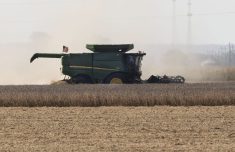SOUTH
Cool, wet weather continues to delay harvest operations, which is well below the five-year average.
Less than 20 percent is combined and less than one third of swathing is complete or ready for straight-cutting.
The Bengough area received the most precipitation with 63 millimetres. The Moosomin area leads the province in rainfall with 783 mm since April 1.
On average, about half the fall rye has been combined, followed by 50 percent of field peas, 35 percent of winter wheat, 30 percent lentils. As well, less than 15 percent of barley, mustard, durum, chickpeas, canola and spring wheat is combined.
Read Also

Trump mulls ending some trade ties with China, including in relation to cooking oil
U.S. President Donald Trump said on Tuesday Washington was considering terminating some trade ties with China, including in relation to cooking oil.
Well over half the canola and one third of the mustard is swathed.
Many crops have lodged and significant downgrading of pulses and cereals due to sprouting or bleaching is expected.
High levels of botrytis and ascochyta can be found in some lentils and high levels of fusarium head blight in cereals.
Topsoil moisture conditions on cropland have an average rating of about 65 percent adequate. Hayland and pastures is rated about 80 percent adequate.
Pasture conditions across the region have an average rating of 68 percent good and 25 percent excellent.
It’s estimated that less than 10 percent of forage crops did not get cut or baled.
CENTRAL
Wet field conditions prevail. An average of five percent of crops are combined and 30 percent swathed or ready to be straight cut.
Precipitation varied from trace amounts to about 17 mm in the Rosthern and Sonningdale areas.
About half of the fall rye is combined, followed by a third of the field peas, a quarter of winter wheat, and less than 10 percent of lentils. About half the canola crop is swathed.
Most crops remain behind normal development. Sprouting and bleaching with pulses and cereals is raising concern and issues of quality. There are reports of high levels of sclerotinia in canola as well as fusarium head blight in cereals.
Topsoil moisture conditions on cropland, hay land and pastures are rated an average of 80 percent adequate.
Pasture conditions have an average rating of 70 percent good with adequate supplies of water for livestock.
About five percent of forage crops did not get cut or baled as a result of excess moisture and lack of dry-down.
NORTH
Harvest operations continue to be delayed by cool, wet conditions.
The Arborfield area received the greatest amount of rainfall with 33 mm.
Less than five percent of the crop is combined with about one third swathed or ready for straight-cutting.
An average of 50 percent of winter wheat is combined, followed by 25 percent of field peas, 10 percent of fall rye, five percent of barley and less than five percent of canola and spring wheat. Slightly more than half the canola is swathed.
Many crops are coming off tough. Also, many have compromised quality due to fusarium head blight and smuts in cereals, as well as potentially high levels of vomitoxin in the seed, and higher than expected levels of sclerotinia in canola.
Topsoil moisture conditions on cropland, hayland and pastures are rated about 80 percent adequate.
Pasture conditions are rated about 55 percent good with adequate water for livestock.
On average, about 10 percent of forage crops did not get cut or baled.
















